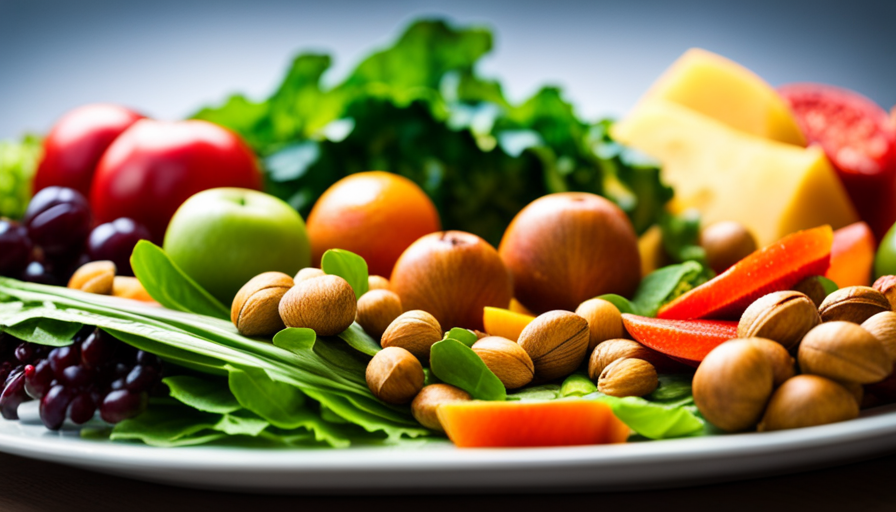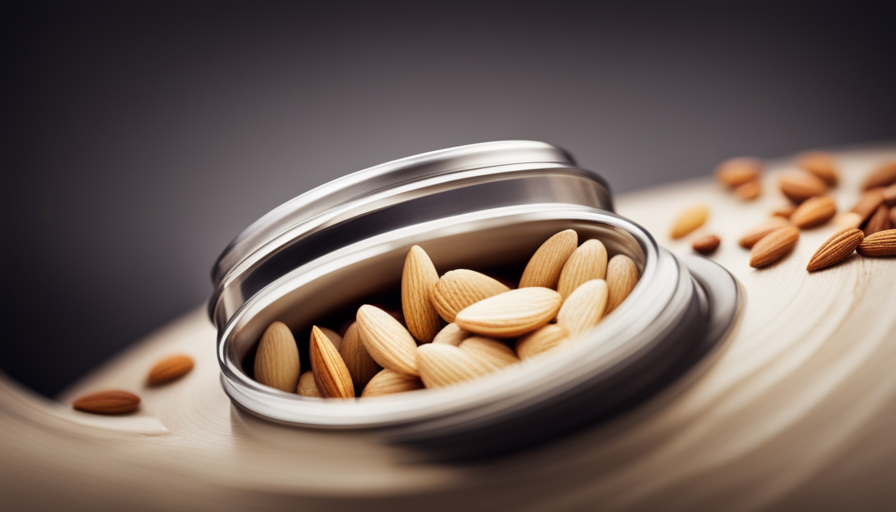Are you doubtful about trying out a raw food diet? Maybe you’re imagining boring and unexciting meals on a plate, without flavor or variety. Let me reassure you, eating on a raw food diet doesn’t have to be like that. In reality, it can be a flavorful and enjoyable way to feed your body.
A raw food diet is based on the belief that cooking destroys essential nutrients and enzymes in food, so it emphasizes consuming unprocessed, uncooked plant-based foods. But don’t worry, you won’t be stuck munching on plain lettuce leaves all day. This lifestyle offers a wide range of flavorful and nutrient-packed options that will keep your taste buds happy.
In this article, we will guide you through the ins and outs of eating on a raw food diet. You’ll learn about the benefits of this lifestyle, how to transition to it, and discover a variety of delicious raw food recipes to keep you satisfied.
So, let’s dive in and explore the exciting world of raw food eating!
Key Takeaways
- Transition gradually and experiment with recipes to find what works best for you
- Incorporate a variety of colorful fruits and vegetables for flavor and weight loss benefits
- Include raw nuts and seeds for their versatility and nutrient-packed benefits
- Explore the use of sprouted grains and legumes for increased nutrients and easier digestion
Understanding the Benefits of a Raw Food Diet
Are you tired of feeling sluggish and struggling with weight gain? Well, by understanding the benefits of a raw food diet, you can start nourishing your body with vibrant, nutrient-dense foods that’ll leave you feeling energized and revitalized.
Understanding the science behind a raw food diet is key to reaping its benefits. Raw foods are rich in enzymes that help with digestion and absorption of nutrients. When food’s cooked, these enzymes are destroyed, making it harder for your body to break down and utilize the nutrients.
Raw foods are also packed with vitamins, minerals, and antioxidants that support overall health and wellbeing.
Exploring the potential drawbacks of a raw food diet is important to make an informed decision. While raw foods offer numerous benefits, it’s essential to ensure you’re getting all the necessary nutrients. A raw food diet can be low in certain nutrients, such as protein, iron, and vitamin B12. Therefore, it’s crucial to carefully plan your meals to include a variety of raw fruits, vegetables, nuts, seeds, and sprouts to meet your nutritional needs.
By understanding the science behind a raw food diet and exploring its potential drawbacks, you can make an informed decision about whether it’s the right choice for you. Remember to consult with a healthcare professional or nutritionist to ensure you’re meeting all your nutritional needs while following a raw food diet.
Transitioning to a Raw Food Lifestyle
Transitioning to a raw food lifestyle can be a challenging yet invigorating journey that allows you to explore a whole new world of nourishment and vitality. Here are some tips to help you make a smooth transition:
-
Start gradually: Begin by incorporating more raw fruits and vegetables into your diet while still enjoying cooked foods. This gradual approach can make the transition easier on your body and taste buds.
-
Experiment with recipes: Explore the abundance of raw food recipes available online or in cookbooks. Trying new dishes will keep your meals exciting and help you discover delicious ways to enjoy raw foods.
-
Find support: Joining a raw food community or finding a supportive friend or family member who shares your interest in this lifestyle can provide encouragement and guidance. They can offer advice, share recipes, and help you stay motivated.
-
Listen to your body: Pay attention to how you feel after eating raw foods. Notice any changes in energy levels, digestion, or overall well-being. This awareness will help you fine-tune your raw food diet to suit your body’s needs.
By following these transitioning tips and finding support, you can embrace a raw food lifestyle with confidence and reap the many benefits it has to offer. Remember, the journey is unique for everyone, so be patient with yourself and enjoy the process of discovering a new approach to eating.
Incorporating Raw Fruits and Vegetables
Start embracing the vibrant world of raw fruits and vegetables, and watch as your taste buds dance with delight. Incorporating raw fruits and vegetables into your diet not only adds a burst of flavor to your meals, but it also brings a plethora of health benefits.
A raw food diet is known for its weight loss benefits, as it’s naturally low in calories and high in fiber, making you feel full while consuming fewer calories. Raw fruits and vegetables are also packed with essential nutrients, vitamins, and minerals that support improved digestion. Their natural enzymes aid in breaking down food, making it easier for your body to absorb nutrients and prevent digestive issues such as bloating and constipation.
To start incorporating raw fruits and vegetables into your diet, make sure to include a variety of colors to ensure a wide range of nutrients. Try adding a handful of leafy greens to your morning smoothie, snacking on crisp carrot sticks or cucumber slices, or enjoying a colorful salad filled with different raw vegetables. You can also experiment with raw fruit desserts, such as banana ice cream or fruit kebabs, for a sweet and healthy treat.
Remember to always wash your fruits and vegetables thoroughly before consuming them raw to remove any potential contaminants. So go ahead, dive into the world of raw fruits and vegetables, and experience the benefits of a raw food diet for weight loss and improved digestion.
Exploring Raw Nuts and Seeds
Delve into the world of raw nuts and seeds, and unlock a treasure trove of nutritious and delicious options for snacking and adding depth to your meals. Raw nuts and seeds are not only packed with essential nutrients, but they also offer a myriad of health benefits. Incorporating them into your raw food diet is a great way to boost your overall well-being.
Raw nuts and seeds are versatile ingredients that can be used in various recipes. From homemade nut butters to energy balls and salads, the possibilities are endless. You can also sprinkle them on top of smoothie bowls or add them to your favorite raw desserts for an extra crunch.
Not only are raw nuts and seeds delicious, but they are also incredibly nutritious. They are excellent sources of healthy fats, protein, fiber, vitamins, and minerals. They have been linked to numerous health benefits, including improved heart health, reduced inflammation, and enhanced brain function.
To help you get started, here is a table showcasing some popular raw nuts and seeds and their health benefits:
| Nut/Seed | Health Benefits |
|---|---|
| Almonds | Rich in vitamin E and magnesium, which support heart health |
| Chia seeds | High in omega-3 fatty acids and fiber, promoting digestive health |
| Pumpkin seeds | Packed with iron and zinc, which support immune function |
| Walnuts | High in antioxidants and omega-3 fatty acids, benefiting brain health |
Incorporating raw nuts and seeds into your raw food diet can provide you with a wide range of health benefits while adding a delicious and satisfying element to your meals. So go ahead, experiment with different recipes and enjoy the goodness that raw nuts and seeds have to offer.
Adding Sprouted Grains and Legumes to Your Diet
Boost your overall well-being by incorporating sprouted grains and legumes into your meals, as they provide a significant increase in essential nutrients compared to their non-sprouted counterparts.
Sprouted grains are grains that have been soaked and allowed to sprout, resulting in increased vitamins, minerals, and enzymes. This process also breaks down anti-nutrients, making the nutrients more bioavailable and easier to digest. Some popular sprouted grains include sprouted quinoa, sprouted brown rice, and sprouted buckwheat.
Legumes, such as chickpeas, lentils, and mung beans, offer numerous health benefits when sprouted. Sprouting legumes not only increases their nutrient content but also reduces their phytic acid and lectin levels, which can interfere with nutrient absorption and digestion. Sprouted legumes are a great source of plant-based protein, fiber, and complex carbohydrates.
To incorporate sprouted grains and legumes into your diet, you can add them to salads, stir-fries, or soups. You can also make delicious sprouted grain bread or use sprouted legumes as a base for veggie burgers or dips. Sprouted grains and legumes can be purchased at health food stores or easily sprouted at home with a little time and effort.
Adding sprouted grains and legumes to your diet is a simple and effective way to enhance your nutrient intake and promote overall well-being. Explore different sprouted grain and legume recipes to enjoy the benefits of these nutritious foods.
Creating Flavorful Raw Sauces and Dressings
Incorporating flavorful raw sauces and dressings into your meals can elevate the taste and nutritional profile of your dishes. Raw sauces are a great way to enhance the flavor of your meals without compromising the health benefits of a raw food diet. By using fresh ingredients like herbs, spices, and fruits, you can create delicious dressings that’ll keep your taste buds satisfied.
One of the benefits of raw sauces is that they retain the natural enzymes and nutrients found in the ingredients. Unlike cooked sauces, which can lose some of their nutritional value during the cooking process, raw sauces preserve the integrity of the ingredients, providing you with a nutrient-dense addition to your meals. They’re also a great way to add variety to your raw food diet, as you can experiment with different combinations of flavors and textures.
When it comes to creating flavorful dressing recipes, the possibilities’re endless. You can make a tangy vinaigrette using apple cider vinegar, olive oil, and fresh herbs. Or, try a creamy avocado dressing with lime juice, garlic, and cilantro. The key’s to use high-quality ingredients and experiment with different flavors until you find the combinations that you enjoy the most.
By incorporating flavorful raw sauces and dressings into your meals, you can enhance the taste and nutritional value of your dishes. Get creative in the kitchen and discover a wide range of delicious options that’ll keep you satisfied on your raw food journey.
Raw Desserts and Sweet Treats
Get ready to indulge your sweet tooth with a tantalizing array of guilt-free, nutrient-rich raw desserts and delectable sweet treats that will leave you craving for more. On a raw food diet, you don’t have to give up desserts. In fact, there are plenty of delicious options that are both healthy and satisfying.
One popular raw dessert alternative to traditional chocolate is raw cacao. Raw cacao is packed with antioxidants and has a rich, chocolatey flavor. You can use raw cacao powder in a variety of desserts, such as raw chocolate truffles or raw brownies. These treats will satisfy your chocolate cravings without the added sugar and processed ingredients.
If you’re looking for a cool and refreshing treat, try making raw ice cream. Traditional ice cream is often loaded with sugar and dairy, but raw ice cream is made with frozen bananas and other fruits. Simply blend frozen bananas with your favorite fruits like strawberries or mangoes, and you’ll have a creamy and delicious ice cream alternative that is both healthy and satisfying.
To give you a visual idea of the options available, here is a table with a few examples of raw chocolate alternatives and raw ice cream recipes:
| Raw Chocolate Alternatives | Raw Ice Cream Recipes |
|---|---|
| Raw Cacao Truffles | Vanilla Banana Ice Cream |
| Raw Brownies | Strawberry Nice Cream |
| Raw Chocolate Bars | Chocolate Avocado Ice Cream |
These recipes are just a starting point, and you can get creative by adding different flavors and toppings to suit your taste. So go ahead and enjoy these guilt-free raw desserts and sweet treats while nourishing your body with nutrient-rich ingredients.
Raw Juices and Smoothies for Optimal Nutrition
Indulge in the refreshing and nutrient-packed goodness of raw juices and smoothies, perfect for fueling your body with optimal nutrition. When following a raw food diet, incorporating raw juices and smoothies into your daily routine can provide numerous benefits. Here are four reasons why you should consider adding them to your diet:
-
Raw juice benefits: Raw juices are an excellent way to obtain essential vitamins, minerals, and enzymes from fruits and vegetables in their purest form. These nutrients are easily absorbed by your body, promoting better digestion and boosting your immune system.
-
Smoothie recipes: Smoothies are a versatile and delicious way to pack in a variety of raw ingredients. From green smoothies with leafy greens like spinach and kale to fruity combinations with berries and tropical fruits, the possibilities are endless. Experimenting with different recipes will keep your taste buds satisfied while providing a wide range of nutrients.
-
Increased energy levels: Raw juices and smoothies are rich in natural sugars, which provide a quick energy boost. Unlike processed sugary drinks, the natural sugars in raw juices and smoothies are accompanied by fiber and other nutrients, preventing blood sugar spikes and crashes.
-
Hydration and detoxification: Raw juices and smoothies are an excellent way to stay hydrated, as they are mostly water-based. Additionally, the high water content helps flush out toxins from your body, promoting detoxification and supporting overall health.
By incorporating raw juices and smoothies into your raw food diet, you can enjoy their numerous benefits while satisfying your taste buds with delicious and nutritious concoctions. Cheers to a healthier you!
Meal Planning and Preparing Raw Meals
Planning and preparing meals with raw ingredients can be a time-saving strategy, with 65% of people who meal prep reporting that it helps them save time during the week.
When it comes to a raw food diet, meal prepping is essential to ensure you have nutritious and delicious meals ready to go.
Start by gathering a variety of raw food recipes that appeal to you. Look for recipes that incorporate fruits, vegetables, nuts, and seeds to ensure a well-rounded meal. Experiment with different flavors and textures to keep things interesting.
Once you have your recipes, make a shopping list and head to the grocery store. Choose fresh, organic produce whenever possible to maximize the nutritional benefits. Stock up on staples like fruits, vegetables, nuts, and seeds, as well as any additional ingredients you may need for your recipes.
When you get home, carve out some time to prep your meals for the week. Wash and chop your fruits and vegetables, and portion them into containers for easy grab-and-go options. You can also prepare dressings, sauces, and dips ahead of time to add flavor to your meals.
By meal prepping on a raw food diet, you can save time and ensure that you have nourishing meals ready whenever hunger strikes. So get creative, experiment with different recipes, and enjoy the benefits of meal prepping with raw ingredients.
Maintaining a Balanced and Sustainable Raw Food Diet
To maintain a balanced and sustainable raw food lifestyle, you’ll discover an array of delicious and nutrient-packed plant-based options that’ll leave you feeling energized and vibrant.
One of the keys to maintaining long-term sustainability on a raw food diet is to ensure you’re getting a variety of fruits, vegetables, nuts, and seeds to meet your nutritional needs. Incorporating a wide range of colorful produce will help provide essential vitamins, minerals, and antioxidants to support overall health.
When it comes to weight loss, a raw food diet can be an effective tool. Raw fruits and vegetables are low in calories and high in fiber, which can help promote a feeling of fullness and reduce calorie intake. However, it’s important to remember that weight loss is a gradual process and should be approached in a healthy and sustainable manner.
To make your raw food diet more sustainable, it’s important to plan your meals in advance and have a variety of options on hand. Experiment with different recipes and flavors to keep things interesting. Incorporate a mix of raw fruits, vegetables, nuts, and seeds to ensure you’re getting a balanced intake of essential nutrients. Additionally, listen to your body and make adjustments as needed. If you find yourself craving certain foods or nutrients, it’s important to honor those cravings and find healthy alternatives to satisfy them.
Remember, maintaining a balanced and sustainable raw food diet is a journey. It’s important to be patient with yourself and make gradual changes that work for you. By incorporating a variety of nutrient-packed plant-based foods, you can enjoy the benefits of a raw food lifestyle while supporting your long-term health and wellness.
Frequently Asked Questions
Can I still get enough protein on a raw food diet?
You might be surprised to learn that you can absolutely get enough protein on a raw food diet! In fact, there are many benefits to a raw food diet for your overall health.
When it comes to protein, raw food sources can be just as effective as cooked food sources. Foods like nuts, seeds, sprouts, and certain vegetables are packed with protein. So don’t worry, you can still meet your protein needs while enjoying the benefits of a raw food diet.
Are there any potential risks or side effects of following a raw food diet?
Potential risks and long-term effects may arise from following a raw food diet. While this dietary approach can provide essential nutrients, it may also lead to deficiencies in certain vitamins, minerals, and protein.
Raw foods can also be harder to digest, causing gastrointestinal discomfort. Additionally, a raw food diet may increase the risk of foodborne illnesses due to the consumption of uncooked foods.
It’s important to consult with a healthcare professional before embarking on this diet to ensure proper nutrition and minimize potential risks.
How do I ensure I am getting all the necessary vitamins and minerals on a raw food diet?
To ensure you’re getting all the necessary vitamins and minerals on a raw food diet, focus on variety. Incorporate a wide range of fruits, vegetables, nuts, and seeds into your meals. Aim for a rainbow of colors to ensure a diverse nutrient intake.
Additionally, consider adding certain superfoods like spirulina, chia seeds, and hemp seeds to boost your nutrient intake. If you’re concerned about specific nutrients, consult a registered dietitian to tailor your raw food diet to meet your individual needs.
Raw food diet tips like these can help you maintain a balanced and nutrient-rich diet.
Can I eat cooked foods occasionally while following a raw food diet?
Yes, you can eat cooked foods occasionally while following a raw food diet. While the main focus of a raw food diet is to consume unprocessed, plant-based foods, incorporating cooked food alternatives can provide some benefits. Cooking certain foods can increase their nutrient availability and digestibility. It also allows for more variety in your diet and can help satisfy cravings. Just remember to choose healthier cooking methods like steaming or baking, and opt for whole, unprocessed ingredients.
Is it possible to gain or lose weight on a raw food diet?
It is possible to manage your weight on a raw food diet, but it requires careful planning and monitoring. Raw foods tend to be lower in calories, which can support weight loss. However, it’s important to ensure that you’re getting all the necessary nutrients to avoid nutritional deficiencies. Including a variety of fruits, vegetables, nuts, seeds, and legumes can help provide the essential vitamins, minerals, and proteins needed for a balanced raw food diet.
Can Beans Be a Part of a Raw Food Diet?
Yes, eating beans raw in diet is possible, but there are a few things to consider. Some beans contain toxins that can be harmful if not cooked properly. Soaking and sprouting beans before consumption can help reduce these toxins. However, it’s important to do thorough research before adding raw beans to your diet.
Conclusion
In conclusion, you now have the knowledge and tools to successfully follow a raw food diet. Remember, "You’re what you eat." Embrace the power of nature’s bounty and nourish your body with vibrant, unprocessed foods.
By incorporating a variety of raw fruits, vegetables, nuts, seeds, and sprouted grains into your meals, you can experience the numerous health benefits of this lifestyle.
With proper meal planning and preparation, you can maintain a balanced and sustainable raw food diet that’ll support your overall well-being.
Start your raw food journey today and witness the transformative power of nature’s purest offerings.










